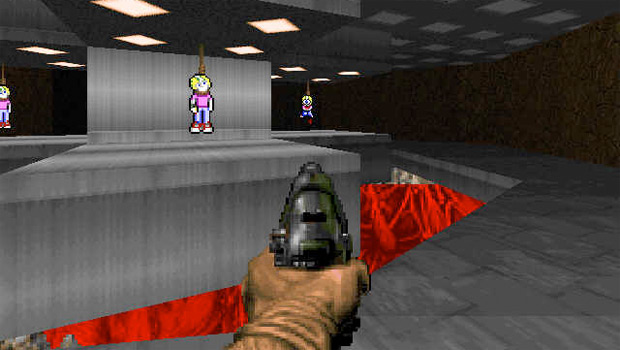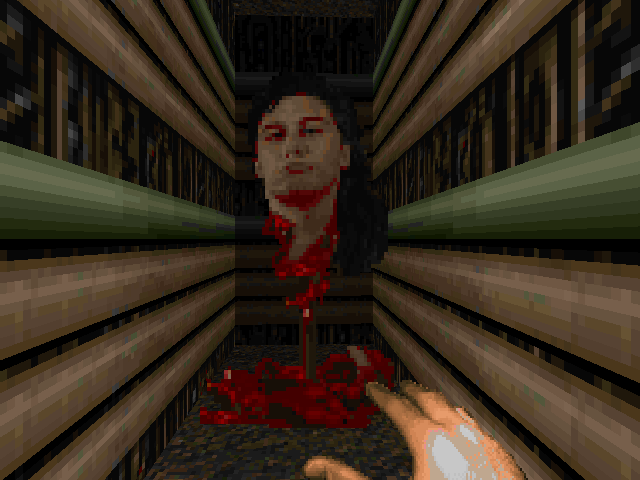[Editor’s Note: Because Doom review copies were not provided ahead of release, we didn’t get to start playing until release yesterday. We’ve now completed the single-player portion, and the review below covers that content. Come back early next week for our thoughts on the multiplayer modes, the SnapMap editor, and of course our final score.]
At its best,
Doom is everything it should be — you, your super shotgun and just barely the amount of ammunition required to kill every single demon on Mars. It feels like a Doom game as you desperately try to find health pickups to keep you going, an ever-growing menagerie of demons snapping at your heels. It's exhausting and exciting and a little bit dumb, and when you're into it you're all the way in. At its worst, Doom is a series of enclosed rooms filled with demons, all of which you must kill to advance. By the time I was halfway through the 8.5-hour-long campaign, hunting down the last Imp in a room so the door will unlock had begun to wear thin.
First impressions wise, Doom strikes all the right notes. The Union Aerospace Corporation's research facility on Mars runs red with the blood of employees who learned a new meaning for the phrase 'wrongful termination,' but that barely matters to the inexplicably mute Doomguy, who shoots anything and everything which moves. Starting with only the pistol encourages you to focus on the diabolically delightful Glory Kill system — shoot your nearest Demon enough that they become staggered and highlighted in blue or orange, and if you press F (or R3 on a PS4 controller) while standing next to them you will rend them asunder. That is to say, you'll tear off their limbs and, in more than a few cases, joyfully beat them with their own appendages.
Lifted wholesale from the still-popular Brutal Doom mod for the original Doom, developer id Software smartly uses these executions to maintain momentum as you play. An executed enemy will drop health packs — critical pickups in a game where you don't regenerate your health out of combat. As you make your way through the UAC facility, the purpose of those health packs becomes clear: They allow you to sprint headfirst into combat (Doomguy's default movement speed is a steady run) and kill as many enemies as you can. If you take too much damage, or if you're running low on ammunition, it’s easy to recover by staggering demons and performing an execution, which gets some health back and removes a threat without using as much ammo. Executions teleport Doomguy a short distance to his target and render him temporarily invincible while they’re carried out, which makes them great for two slightly left-of-centre things — getting a moment's ironic peace in the middle of a firefight, and teleporting yourself loose when you clip through the floor (which happened to me more than a few times).
The demon outbreak on the facility is a result of worst business plan of all time — to rob Hell of its energy resources — and security precautions see to it that you cannot open most doors if any demons are still alive. These are kill chambers, a relic of an era of shooter design all but gone, designed to contain you and force you into a particular playstyle. Where games with regenerating health reward players who hide and pick off enemies one at a time, Doom instead forces you to map out a path through the chamber trying to find health without ever stopping long enough to become overwhelmed.
It's a design philosophy which runs counter to the nature of the execution system. Glory Kills promote a forward momentum, encouraging you to move towards enemies to close the distance and earn your health pickups, but the kill chamber map style does the opposite. Your best strategy is to move backwards through the chamber, away from the enemies, and to do damage as you go. The AI in Doom is not particularly smart, and you can rely on it to roughly converge on your location (even when it can't see you and shouldn’t know where you are). So if you run in circles around the kill chamber, shooting behind you and dodging projectiles, you can kill the majority of the enemies within — only after you've thinned the herd of Demons can you then start running forward and killing them by circle-strafing (running around them in circles).
It might seem like an odd complaint, because I've praised Doom for how old-school it feels, and circle-strafing in kill chambers is an old-school staple. But in the old days rooms like these were products of an era where enemy AI wasn't capable of the surprisingly scary tactics we see in shooters these days. In Doom it seems more like a crutch — if the enemies were more capable of advanced tactics and teamwork the shooting would be more interesting, and I wouldn't need to be locked in a room to want to kill everything in sight. That doesn't mean it's bad, but it's just about the only trick up Doom’s sleeve, and it doesn't take too long before it wears thin.
The quality of the shooting itself varies depending on which of the eight weapons you use. The Super Shotgun is brilliant — good enough that by the end of the campaign I was only using other weapons long enough to get shotgun ammo back. The beautiful finish on the double-barrel gun captures the nostalgic vibe of the older games while delivering a hefty wallop across a wide spread, which makes it great against the bigger enemies you end up fighting dozens of. On the other end of the spectrum is the Rocket Launcher, which feels underpowered and redundant. Especially after you’ve upgraded the Heavy Assault Rifle and the Combat Shotgun to posses explosive alternate fire modes, the Rocket Launcher barely seems worth the effort required to draw it. Weapons sharing ammunition between archetypes – like the Plasma Cannon and Gauss Rifle both using plasmoids – is an odd concession to nostalgia, because you get all the weapons quite early (especially if you're hunting for secret areas). This meant my use of weapons like the Combat Shotgun were relegated to accidental weapon switches, because I was leery of using up my Super Shotgun ammunition on the weaker of the two guns.
Of course, The BFG 9000 makes an appearance and occupies an interesting place in the weapon lineup. Moved away from the weapons wheel, the BFG has its own dedicated button (T or Triangle) which emphasises its importance in your arsenal. When you fire it, it vapourises everything in a very large radius: green ionic charges arc from the first enemy you hit and into every other demon nearby, and the gibs soon fill the air like confetti at an environmentally irresponsible parade. It's a quick charging Win Button, but that's what the BFG is supposed to be. The only drawback is that it's so powerful, especially if you train your enemies behind you into an easily obliterated mob, that I often found myself holding off on using it, waiting for bigger waves to arrive... until suddenly everything was dead and I didn't get to use it at all.
Those hordes of demons come in all shapes and sizes. The enemies start out quite tame, a wide array of lumbering zombie types for you to gib and execute at your leisure. As the campaign progresses the demons start to grow, trading warped humans for bigger, meaner monsters direct from Hell, including the iconic lineup of classics The Pinky demon returns to provide a fantastic fight: your first encounter with this squat, blister-red charging demon is tough, because he closes the distance so quickly and shrugs off most shots to the face. Eventually Pinkys will be the cannon fodder you fight as you concentrate on more pressing threats like the cycloptic Mancubus, which has guns for arms and does long-range, mid-range, and short-range damage. The Barons of Hell were my favourite to fight, despite their relative simplicity. Towering demons with horned heads and chitinous armour plating beneath their skin, they rely on close-range attacks and are capable of getting into range very quickly. My one complaint about the monsters is that the possessed grunts which make up the bulk of the cannon fodder sound amateurish. Part gargle, part screaming, their repetitive ambient cries for attention grate on the nerves well before halfway through the campaign.
The only enemies more imposing than the Barons of Hell were boss fights, where Doom takes on a very different feel. The bosses possess a wide array of attacks, which turned them into dexterity-based puzzles. Shooting them in the face while running backwards won't work against these enemies, so you need to work out their attacks, figure out how to dodge them, and shoot whatever their weak spot is. I don't want to spoil them so I'll avoid specific details, but one boss fight will test the limits of your ability to dodge in 3D space as it hammers you with long-distance attacks. Shooter bosses are so often massive bullet sponges and little else these days, which makes Doom's big fights feel that much more satisfying to win. In each boss fight I died at least twice just trying to memorise the way the attacks were telegraphed as well as the best way to avoid them.
Doom's biggest concession to the new school — progression by way of a weapon and armour upgrade system — is definitely for the best. It encourages you to seek out the levels’ many secrets, confident your diligent scrounging will be rewarded with an expansion for your health pool, the opportunity to improve your rocket launcher, or an upgrade for your body armour which allows you to switch weapons faster.
In that specific way, the level design — when it isn't locking you into a room filled with demons — is brilliant. The approach creates an organic flow to accommodating you depending on how you want to play. If you just want to skip from kill chamber to kill chamber you can, but you'll inevitably notice out-of-place elements to investigate, and you'll begin to understand the breadth of the level itself as you go. A casual secret-hunter will come across upgrades just by taking the path less travelled, but there are tiers above that. A committed hunter will always be on the lookout for oddities in the otherwise perfect placement of the levels, and they'll need to do some solid first-person platforming to reach their objective. The really keen secret-finders will wind up making some spectacular leaps of faith in their quest to reach runes, collectable Doomguy dolls, and upgrades. The layers of secret building, along with the platforming, lead to an opportunity for you to dictate how much downtime you have in between high-octane killathons, and it's a great way to grab a breather.
Performance-wise, Doom is id Software's best game in years. RAGE had oodles of problems even for those lucky few with the right combination of PC parts, but Doom's biggest flaws thus far have been a few error-less crashes to desktop and some extremely odd clipping issues. Outside of a handful of errors it ran at a solid 60 frames per second, and it looks great while doing so. The way it handles lighting is sometimes reminiscent of Doom 3's too-dark world, but here they waste no time in illuminating things. The same attention to detail paid to the level design has been given to the world art, which means there are always interesting elements of the world to infer from the environments, like vehicle repair bays filled with the equipment necessary to fix the Mars-roving trucks on the base, including stacks of spare tyres. The only trick here is that you need to slow down enough to actually look.
Doom’s industrial rock soundtrack is great, but I would expect nothing less. I don't think it's as good as the soundtrack in the original, but the way the tempo drives and signposts action makes it a solid substitute. It almost feels more like Quake than it does Doom, but it still hits all the right notes, and the original game's compositions are definitely present.







![Glory to Codexia! [2012] Codex 2012](/forums/smiles/campaign_tags/campaign_slushfund2012.png)

















